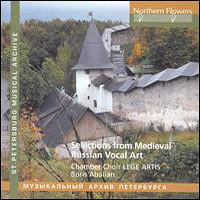In Celebration of the Human Voice - The Essential Musical Instrument
Home | Doo Wop | Barbershop | World | Contemporary | Christian | Vocal Jazz | Choral | Christmas | Instructional | Arrangements
Classical | Opera | Musicals | Personality | Young Singers | Disney | Videos | Songs | The Artists

Lege Artis Chamber Choir
Medieval Russian Vocal Art
 |
|
Directed by Boris Abalian
The legend of adoption of Christianity in Russia as stated in the Chronicle of Years and Times has it that the unprecedented beauty of divine service was the main reason for choosing the Byzantine model of Christian faith. Church singing heard by Prince Vladimir's ambassadors in Constantinople amazed them with its delightful beauty. The Byzantine aesthetics inheriting the Platonic doctrine of identity of beauty, truth, and deity proved to be very close to the heart of ancient Slavs, and had a tremendous impact on generation of a new professional singing culture in Russia. Znamenny chant, a greatest achievement of medieval culture, was the core chant in singers' repertoire over the whole history of sacred singing in Ancient Russia. New styles of singing, Putevoy and Demestvenny chants, appear in the second half of the 15th century. The Putevoy chant competed with the Znamenny in popularity, and was a nationwide model along with it. The demestvenny chant is one of the most beautiful melismatic chants in the vocal heritage of Old Russia. Another impressive branch of the ancient Russian art of singing is professional polyphony. The sound of early Russian polyphonic chants is unusual for today's audience. Their line compositions are based on a protracted putevoy chant "braided" with background voices. Added to demestvenny polyphony was a striking, rhythmically active "demestvo" part. Russian Tsar Alexey Mikhailovich, father of Peter the Great, was taught line singing as a child, and afterwards collected a remarkable music library. |
| Item code: 6038C | 1 CD | $16.95 |
| Choral | Mixed | Russia |
| 034069992723 | 9927 |
Related: Russian a cappella |
